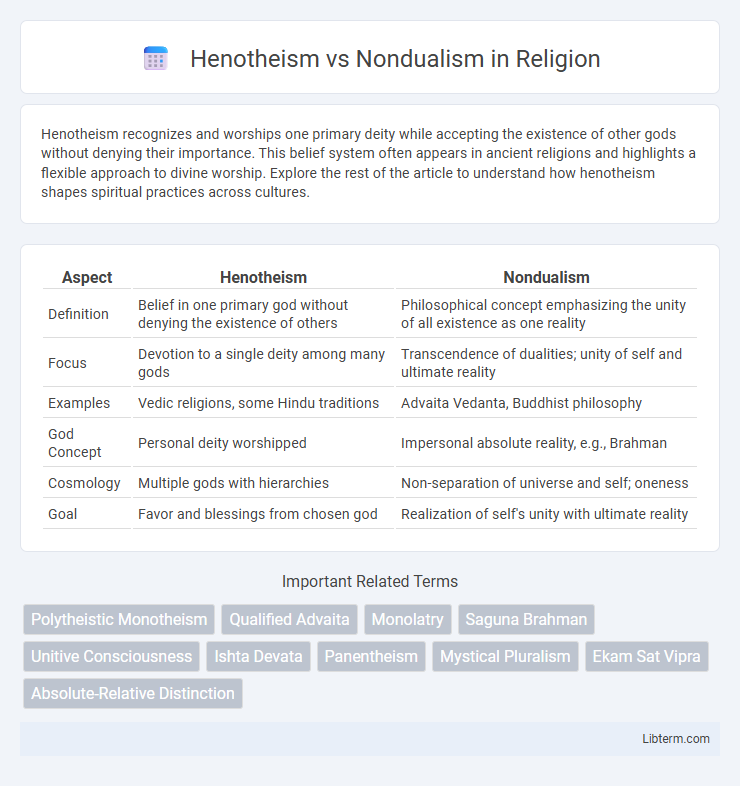Henotheism recognizes and worships one primary deity while accepting the existence of other gods without denying their importance. This belief system often appears in ancient religions and highlights a flexible approach to divine worship. Explore the rest of the article to understand how henotheism shapes spiritual practices across cultures.
Table of Comparison
| Aspect | Henotheism | Nondualism |
|---|---|---|
| Definition | Belief in one primary god without denying the existence of others | Philosophical concept emphasizing the unity of all existence as one reality |
| Focus | Devotion to a single deity among many gods | Transcendence of dualities; unity of self and ultimate reality |
| Examples | Vedic religions, some Hindu traditions | Advaita Vedanta, Buddhist philosophy |
| God Concept | Personal deity worshipped | Impersonal absolute reality, e.g., Brahman |
| Cosmology | Multiple gods with hierarchies | Non-separation of universe and self; oneness |
| Goal | Favor and blessings from chosen god | Realization of self's unity with ultimate reality |
Introduction to Henotheism and Nondualism
Henotheism centers on the worship of one primary deity while accepting the existence of other gods, blending monotheistic devotion with polytheistic acknowledgment. Nondualism emphasizes the fundamental unity of all existence, asserting that distinctions between self and other, or deity and creation, are ultimately illusory. Both perspectives offer distinct metaphysical approaches: henotheism navigates multiple divine entities with primary allegiance, whereas nondualism seeks an underlying oneness beyond multiplicity.
Defining Henotheism: Core Principles
Henotheism is defined by the worship of one supreme deity without denying the existence of other gods, emphasizing exclusive devotion while accepting a broader divine reality. Core principles include acknowledging a single primary god as supreme within a pantheon and allowing subordinate deities to exist without equal worship. This belief system contrasts with nondualism, which transcends dualistic distinctions by recognizing an underlying unified reality beyond individual gods.
Understanding Nondualism: Fundamental Concepts
Nondualism centers on the fundamental concept of the unity of existence, asserting that all distinctions between self and other, subject and object, are ultimately illusory. It emphasizes the realization that the individual soul and the universal consciousness are identical, transcending dualistic perceptions of reality. This philosophical framework contrasts with henotheism, which acknowledges multiple deities but elevates one as supreme, while nondualism dissolves all separations into a singular, unified reality.
Historical Origins of Henotheistic Beliefs
Henotheism traces its historical origins primarily to the ancient Vedic religion of India, where early texts such as the Rigveda reveal devotion to a single deity while acknowledging the existence of others. This belief system contrasts with nondualism, which emerged prominently in Advaita Vedanta philosophy, emphasizing the unity of the individual soul and ultimate reality (Brahman) without privileging one god over others. The henotheistic approach allowed worshippers to focus on one god within a broader pantheon, reflecting a transitional stage between polytheism and monotheism.
Evolution of Nondualism in World Philosophies
Nondualism evolved through diverse world philosophies including Advaita Vedanta in India, which emphasizes the oneness of Atman and Brahman, and Taoism in China, focusing on the indivisibility of Tao. Henotheism, characterized by devotion to one deity without denying others, contrasts with nondualism's principle of ultimate unity beyond plurality. The evolution of nondualism influenced various spiritual traditions by promoting transcendence of dualities and fostering holistic understanding of existence.
Key Differences Between Henotheism and Nondualism
Henotheism centers on the worship of one primary deity while acknowledging the existence of other gods, emphasizing a pluralistic yet preferential approach to divinity. Nondualism posits the fundamental oneness of all reality, transcending the distinction between the divine and the individual self, thus rejecting multiplicity in essence. The key difference lies in henotheism's recognition of multiple deities with one supreme focus, contrasted with nondualism's philosophical assertion of an underlying singular unity beyond all forms.
Influential Texts and Traditions
Henotheism is prominently reflected in the Vedas, especially the Rigveda, where individual deities are worshiped as supreme in different hymns, exemplifying the tradition of honoring one god without denying others. Nondualism finds its authoritative foundation in the Upanishads, particularly texts like the Chandogya and Brihadaranyaka Upanishads, which emphasize the unity of Atman (self) and Brahman (ultimate reality). These traditions influence diverse spiritual practices, with henotheism shaping early Vedic rituals and nondualism underpinning Advaita Vedanta philosophy as articulated by Adi Shankaracharya.
Religious Practices and Rituals
Henotheism involves worshiping one primary deity while acknowledging the existence of others, with rituals often centered on offerings, prayers, and festivals dedicated to the chosen god. Nondualism emphasizes the unity of all existence, leading to meditative and contemplative practices aimed at transcending individuality and realizing oneness with the ultimate reality. Religious rituals in nondualism typically include meditation, silence, and internal spiritual disciplines rather than external worship of multiple deities.
Modern Interpretations and Relevance
Modern interpretations of henotheism emphasize the reverence of one deity without denying the existence of others, reflecting a pluralistic approach in contemporary spirituality and interfaith dialogue. Nondualism, increasingly integrated into mindfulness and holistic wellness movements, highlights the essential unity beyond apparent dualities, influencing psychological and philosophical frameworks. Both concepts remain relevant as they offer flexible paradigms for understanding divinity and existence in a multicultural and interconnected world.
Comparative Analysis: Impacts on Spirituality
Henotheism emphasizes devotion to a single deity while acknowledging other gods, shaping spirituality through personalized divine relationships and ritual practices. Nondualism promotes the realization of oneness beyond dualistic distinctions, fostering an experiential understanding of ultimate reality and inner transformation. The comparative impact reveals henotheism's focus on external worship and moral codes, contrasted with nondualism's inward path to transcendence and universal consciousness.
Henotheism Infographic

 libterm.com
libterm.com